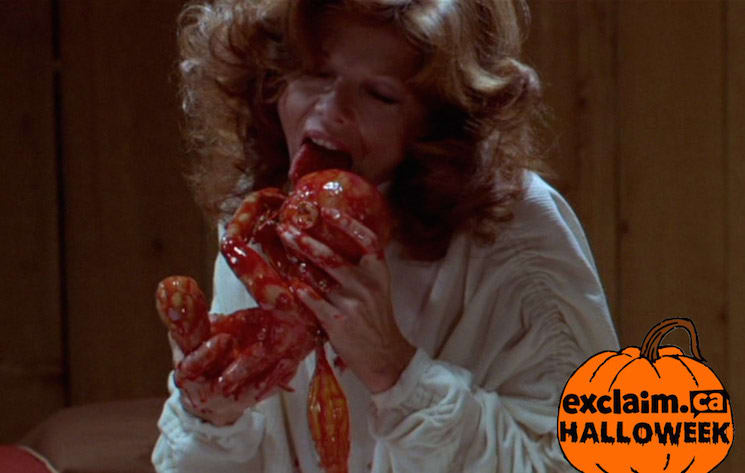Really, this guide could have consisted of five David Cronenberg films, considering the footprint he's left on Canadian horror cinema. The auteur has received such international acclaim for his inimitable style of body horror and psychological terror that he has become the genre's most significant contributor. But there is a real history to be discovered and appreciated beyond Cronenberg. (For anyone looking to go deep, try Caelum Vatnsdal's highly educational book, They Came From Within A History of Canadian Horror Cinema.)
Chances are, you haven't watched too many horror films simply because they're Canadian. Unlike Italy, France, Japan, South Korea or Britain, which have spawned their own cult followings, Canada hasn't received the same levels of interest for its homegrown frights. And it's a bit baffling, because if Canadian filmmaking thrives in one particular area, it's horror. Since the release of 1961's 3D ride The Mask, which is recognized as the first Canadian horror, the Great White North has become a fruitful nation for original and not-so original horror flicks.
What makes our cinema unique is how it acknowledges and celebrates "Canadiana." One of the great Canadian signatures is the use of our hostile winters as a milieu. The cold isolation is a constant threat that can be as deadly as any crazed killer on the loose, as witnessed in Cannibal Girls, Curtains and The Changeling. There's also an innate search for identity, something Canadians are all too familiar with: the relentless metamorphosis terrorizing characters throughout Cronenberg's catalogue, the hairy menstruating of a teenage girl in Ginger Snaps, and the delusion of befriending a medical doll in Pin. Another signature on a slightly lesser scale is our beer. Yep, Canadian suds have played a supporting role in both My Bloody Valentine and The Corpse Eaters; just try not to notice them peppered throughout those two films.
While no Canadian horror film has never quite found a box office breakthrough on par with the Halloweens, the Nightmare On Elm Streets or the Friday the 13ths of the world, there is plenty of reason to be proud: we paid for a lot of them with our tax dollars.
Essential Films:
5. The Editor (2014)
The most recent horror flick of note to come from our country is also arguably the best one in 20 years or so. Made by the Winnipeg-based collective Astron-6, The Editor is part satire, part homage to the Italian giallo genre. Marketed as a "giallo-comedy," everything from gallons of orange-red paint as blood and creeping, slow camera work to deliberately bad vocal dubs and over the top violence that is as amusing as it is gory (one scene where a woman's face rips off is an undeniable gas) is masterfully done as a send up. But it's not all in jest. This film looks as vivid and genuine as any original giallo, with expertly replicated lighting and jump cuts. The vintage-sounding synth score, featuring Goblin member Claudio Simonetti, is also a nice touch, deserving a vinyl release of its own. Based in 1980, the meta-heavy plot is a simple one that follows a veteran editor with severed fingers (played by co-director/writer Adam Brooks) who is the prime suspect of a series of murders around the set. With B-movie legend Udo Kier and future B-movie legend Paz de la Huerta in bit parts, it goes heavy on the giallo shtick and never relents.
4. Pin (1988)
In a way you could call Pin the Canadian Chucky – but a Good-Guy has nothing on an anatomically correct medical dummy when it comes to creepy dolls. Shot in Montreal, this homegrown film written and director by Sandor Stern (best known for penning the screenplay to The Amityville Horror) stars Pin, a life-sized dummy used by Doctor Linden (Lost's Terry O'Quinn) in his practice to not only communicate with his patients but also his two neglected children. His socially despondent son Leon (portrayed as an adult by David Hewlett) becomes emotionally attached to Pin and as a schizophrenic, transfers his personality over to Pin, who becomes an accessory to his violent crimes. Pin is a commentary on mental illness, but manifests the condition through one of the most dark and disturbing fears a lot of us have: spooky inanimate objects that we secretly feel are watching us. Though it wasn't the first of its kind (see preceding examples in Magic, Dolls or the clown in Poltergeist), there is something extremely off-putting about Pin, be it early on as a transparent being with organs, veins and muscles exposed or later, after Leon covers him in synthetic flesh.
3. My Bloody Valentine (1981)
When it comes to 1980s slasher flicks, My Bloody Valentine often gets lost in the adoration for successful franchises like Friday the 13th, A Nightmare On Elm Street, Halloween and even Sleepaway Camp. But this despite the unoriginal idea – i.e. jumping on the holiday-themed bandwagon – there is a reason why Quentin Tarantino considers it his favourite slasher of all time. Set in the mining town of Valentine Bluffs (really Sydney Mines, Nova Scotia), the killer is a survivor of a negligent mine disaster that occurred on Valentine's Day. Twenty years later, he returns to the town to kill anyone celebrating the holiday as an act of vengeance. It sounds hokey, and at times it is, but director George Mihalka came up with some pretty brutal and original death scenes that forever stay with you: that mine pick into a man jowls and out of his eye socket, drowning a man in a boiling pot of hot dogs and of course, putting poor Mabel into the clothes dryer. All of those scenes were so controversial that they had to be edited in order to avoid an X rating. As a horror icon, the Miner, as he's called, isn't quite as celebrated as Michael Myers or Jason Voorhees, but he's just as terrifying with his impenetrable mask, his heavy breathing and a hulking ability to wield his miner pick. However, why My Bloody Valentine remains one of the great Canadian horror films is its embrace of Canadian culture through Nova Scotian accents and the overt placement of Moosehead beer.
2. The Brood (1979)
Selecting one David Cronenberg film, even just one of his horrors, is a tall order. Although it's not as popular as Videodrome or Dead Ringers, The Brood fits the bill better than any of them. It stars legendary English actor Oliver Reed as a radical psychotherapist treating a severely disturbed mother named Nola (Samantha Eggar), who is battling her ex-husband Frank (Canadian great Art Hindle) for custody of their five-year-old daughter, Candice. It doesn't sound that much like a horror, but that all comes when Nola releases a "brood" of child monsters to kill anything that stops them from retrieving Candice for her. It gets even more bizarre in the final sequence, which answers the question: why don't humans lick newborns the way cats do? Filmed in the GTA, Cronenberg calls The Brood "the most classic horror" he's done, but it's also the most personal film he's done: the custody battle between Frank and Nola mirrored a real life fight for his own daughter, Cassandra.
1. Black Christmas (1974)
There is no real contest: Black Christmas is the definitive Canadian horror film. Not just because 40 years after its release it remains to be creepy and thrilling, but because it invented the slasher prototype. Every movie from Halloween to Friday the 13th to Scream borrowed Bob Clark's blueprint of a crazed serial killer stalking teenagers, but even by comparison his deserves the honour of the greatest slasher ever. Set inside a sorority house during the holiday season (shot on the U of T campus), a mysterious caller keeps harassing one sister named Jess (Olivia Hussey); unbeknownst to her, each of her sisters is being killed off throughout the house. An adaptation on "The Babysitter and the Man Upstairs" urban legend, Clark's use of the killer's POV adds an unsettling element that was undoubtedly the inspiration for Michael Myers' first kill in Halloween. What might be the film's greatest achievement, however, is making the protagonist not only a young woman, but also a young woman who's pregnant, which at the time was the unlikeliest hero against a homicidal lunatic. With supporting turns by familiar faces in John Saxon, Margot Kidder and Art Hindle, Black Christmas is a favourite film of every horror fanatic, and not just noted fan Steve Martin.
What To Avoid:
Not all of these franchises, however, are co-productions. Prom Night, a classic slasher that snagged Jamie Lee Curtis, fresh off the first two Halloween films, launched a series of films that descended into the inane. The original presented a somewhat logical premise – a masked killer seeks revenge for the death of a young girl and terrorizes high schoolers on prom night – and yet, from there it opted to fall into absurdist supernatural phenomena with the next two sequels. I'll give Hello Mary Lou: Prom Night II some credit: it is fabulously over the top and a real guilty pleasure. However, its successors, The Last Kiss and Deliver Us From Evil, which is so far off base it doesn't even feature a prom, are pure trash.
Even George A. Romero had his moments of failure up here in Canada, writing and directing two zombie flicks that failed to capitalize on the first three installments of his "Living Dead" series. Land of the Dead was a disappointing attempt to re-enter the genre he invented. Despite its sizeable budget, it felt like a modern retread of its predecessor, Day of the Dead. Meanwhile, the last two entries, Diary of the Dead and Survival of the Dead made cases for the director to hang up his slate.
The late 1990s and 2000s were a rough time for Canadian horror. There was a real glut of straight-to-DVD productions hitting the market with uninspired titles like Evil Breed: The Legend of Samhain, Avalanche Sharks and Decoys 2: Alien Seduction.
Further Viewing:
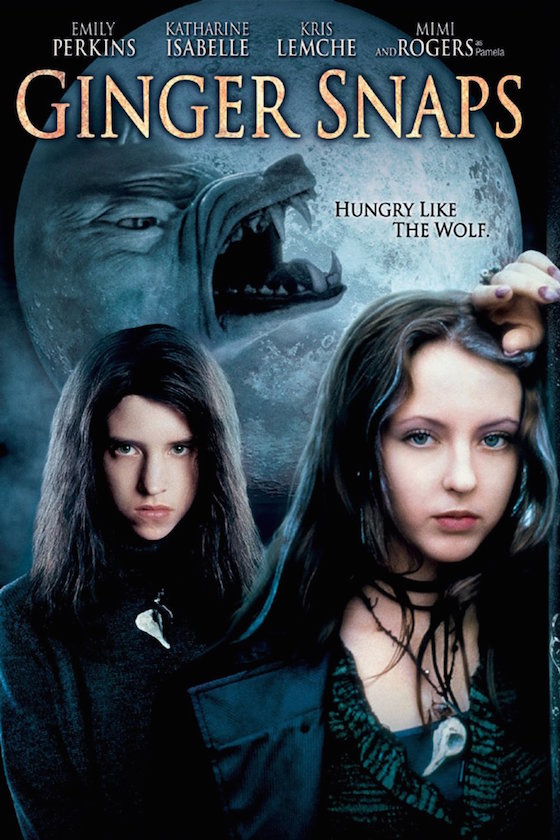
If you want to go back to the very beginning, The Mask (1961) is recognized as the first ever Canadian horror flick. This cult classic, originally released in 3D, is a dark and disturbing trip about a psychiatrist who comes into the possession of an antique mask that gives him psychedelic and nightmarish visions. Why The Mask was so effective was because of its use of 3D technology, instructing the viewer to don the red and blue glasses whenever the doctor muttered, "Put the mask on, NOW!" The film has recently been digitally restored, and received a week-long run at the TIFF Lightbox in Toronto.
Though it narrowly missed out on the list, Ginger Snaps (2000) is one of the most inventive horror films ever made. Teenage sisters are attacked by a werewolf; one of them turns, and the other tries to help her sister cope and eventually reverse the affliction. Like An American Werewolf In London, Ginger Snaps (and its 2004 sequel) blend horror with black comedy, but turn the convention on its head by turning in a teenage girl's transformation into a metaphor for menstruation. With a wildly original script by Karen Walton, Ginger Snaps is fun, subversive and a rare feminist horror that goes to bat for teenage female empowerment.
Before he made Black Christmas, Bob Clark made Deathdream (1972), a nasty little film in Florida about an allegedly deceased Vietnam vet who unexpectedly returns home to his family undead and hungry for blood. Not explicitly a zombie (he can walk and talk and socialize) or a vampire (he uses blood as a youth serum and prefers to inject it rather than drink it) flick, Clark presented audiences with a refreshingly ambiguous yet extremely creepy premise that surprisingly hasn't been rebooted yet.
Remember how Kevin McAllister in Home Alone mistakenly thought the old guy with the shovel was a killer? Maybe Kevin watched Deranged: Confessions of a Necrophile (1974) at a very young age and couldn't shake the resemblance between his neighbour and Ezra Cobb. Like Norman Bates, Leatherface and Hannibal Lecter, Cobb was another fictional character based on real life serial killer Ed Gein, who digs up corpses and kills innocent women, then cross-dresses in their flesh. Like The Texas Chain Saw Massacre, which came out the same year, it's a haunting flick that feels unsettlingly real.
Other horror worth tracking down on VHS include Richard Ciupka's casting call whodunit, Curtains (1983), starring The Brood's Samantha Eggar and features the infamous "ice skating scene" and a truly grotesque killer mask; The Changeling, a creepy, good old fashioned ghost story starring George C. Scott as a famous composer who loses his wife and daughter to an accident and moves into a turn of the century mansion to resume his career, only to find it haunted by a dead child's ghost; The Corpse Eaters, arguably the first real graphic zombie film and definitely the first to both be shot in Sudbury and force the cast to drink Molson Ex; the Hal Holbrook-starring wilderness thriller, Rituals (a.k.a. The Creeper), which earned the nickname "Northern Deliverance;" and Cannibal Girls (1973), Ivan Reitman's second film, starring a young Eugene Levy and Andrea Martin as a couple whose car breaks down in the middle of winter and become stranded in a small town run by the titular, human-eating characters. The film was deemed so controversial at the time, that during screenings the sound of a bell in the theatre would warn the "squeamish or prudish" viewers to close their eyes so they could avoid "witnessing certain scenes of an especially erotic or gruesome nature."
Chances are, you haven't watched too many horror films simply because they're Canadian. Unlike Italy, France, Japan, South Korea or Britain, which have spawned their own cult followings, Canada hasn't received the same levels of interest for its homegrown frights. And it's a bit baffling, because if Canadian filmmaking thrives in one particular area, it's horror. Since the release of 1961's 3D ride The Mask, which is recognized as the first Canadian horror, the Great White North has become a fruitful nation for original and not-so original horror flicks.
What makes our cinema unique is how it acknowledges and celebrates "Canadiana." One of the great Canadian signatures is the use of our hostile winters as a milieu. The cold isolation is a constant threat that can be as deadly as any crazed killer on the loose, as witnessed in Cannibal Girls, Curtains and The Changeling. There's also an innate search for identity, something Canadians are all too familiar with: the relentless metamorphosis terrorizing characters throughout Cronenberg's catalogue, the hairy menstruating of a teenage girl in Ginger Snaps, and the delusion of befriending a medical doll in Pin. Another signature on a slightly lesser scale is our beer. Yep, Canadian suds have played a supporting role in both My Bloody Valentine and The Corpse Eaters; just try not to notice them peppered throughout those two films.
While no Canadian horror film has never quite found a box office breakthrough on par with the Halloweens, the Nightmare On Elm Streets or the Friday the 13ths of the world, there is plenty of reason to be proud: we paid for a lot of them with our tax dollars.
Essential Films:
5. The Editor (2014)

The most recent horror flick of note to come from our country is also arguably the best one in 20 years or so. Made by the Winnipeg-based collective Astron-6, The Editor is part satire, part homage to the Italian giallo genre. Marketed as a "giallo-comedy," everything from gallons of orange-red paint as blood and creeping, slow camera work to deliberately bad vocal dubs and over the top violence that is as amusing as it is gory (one scene where a woman's face rips off is an undeniable gas) is masterfully done as a send up. But it's not all in jest. This film looks as vivid and genuine as any original giallo, with expertly replicated lighting and jump cuts. The vintage-sounding synth score, featuring Goblin member Claudio Simonetti, is also a nice touch, deserving a vinyl release of its own. Based in 1980, the meta-heavy plot is a simple one that follows a veteran editor with severed fingers (played by co-director/writer Adam Brooks) who is the prime suspect of a series of murders around the set. With B-movie legend Udo Kier and future B-movie legend Paz de la Huerta in bit parts, it goes heavy on the giallo shtick and never relents.
4. Pin (1988)
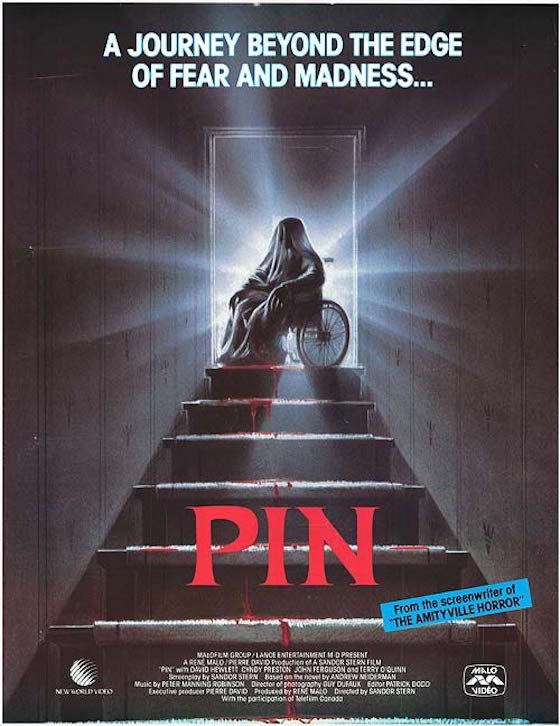
In a way you could call Pin the Canadian Chucky – but a Good-Guy has nothing on an anatomically correct medical dummy when it comes to creepy dolls. Shot in Montreal, this homegrown film written and director by Sandor Stern (best known for penning the screenplay to The Amityville Horror) stars Pin, a life-sized dummy used by Doctor Linden (Lost's Terry O'Quinn) in his practice to not only communicate with his patients but also his two neglected children. His socially despondent son Leon (portrayed as an adult by David Hewlett) becomes emotionally attached to Pin and as a schizophrenic, transfers his personality over to Pin, who becomes an accessory to his violent crimes. Pin is a commentary on mental illness, but manifests the condition through one of the most dark and disturbing fears a lot of us have: spooky inanimate objects that we secretly feel are watching us. Though it wasn't the first of its kind (see preceding examples in Magic, Dolls or the clown in Poltergeist), there is something extremely off-putting about Pin, be it early on as a transparent being with organs, veins and muscles exposed or later, after Leon covers him in synthetic flesh.
3. My Bloody Valentine (1981)
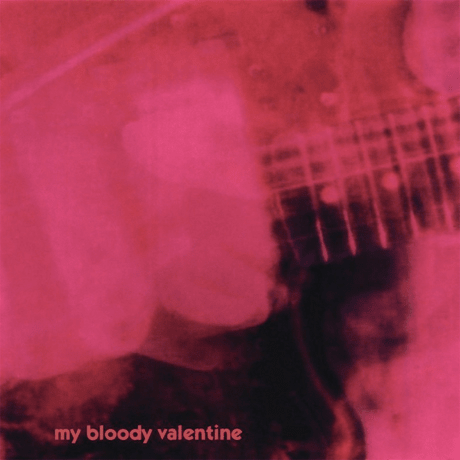
When it comes to 1980s slasher flicks, My Bloody Valentine often gets lost in the adoration for successful franchises like Friday the 13th, A Nightmare On Elm Street, Halloween and even Sleepaway Camp. But this despite the unoriginal idea – i.e. jumping on the holiday-themed bandwagon – there is a reason why Quentin Tarantino considers it his favourite slasher of all time. Set in the mining town of Valentine Bluffs (really Sydney Mines, Nova Scotia), the killer is a survivor of a negligent mine disaster that occurred on Valentine's Day. Twenty years later, he returns to the town to kill anyone celebrating the holiday as an act of vengeance. It sounds hokey, and at times it is, but director George Mihalka came up with some pretty brutal and original death scenes that forever stay with you: that mine pick into a man jowls and out of his eye socket, drowning a man in a boiling pot of hot dogs and of course, putting poor Mabel into the clothes dryer. All of those scenes were so controversial that they had to be edited in order to avoid an X rating. As a horror icon, the Miner, as he's called, isn't quite as celebrated as Michael Myers or Jason Voorhees, but he's just as terrifying with his impenetrable mask, his heavy breathing and a hulking ability to wield his miner pick. However, why My Bloody Valentine remains one of the great Canadian horror films is its embrace of Canadian culture through Nova Scotian accents and the overt placement of Moosehead beer.
2. The Brood (1979)

Selecting one David Cronenberg film, even just one of his horrors, is a tall order. Although it's not as popular as Videodrome or Dead Ringers, The Brood fits the bill better than any of them. It stars legendary English actor Oliver Reed as a radical psychotherapist treating a severely disturbed mother named Nola (Samantha Eggar), who is battling her ex-husband Frank (Canadian great Art Hindle) for custody of their five-year-old daughter, Candice. It doesn't sound that much like a horror, but that all comes when Nola releases a "brood" of child monsters to kill anything that stops them from retrieving Candice for her. It gets even more bizarre in the final sequence, which answers the question: why don't humans lick newborns the way cats do? Filmed in the GTA, Cronenberg calls The Brood "the most classic horror" he's done, but it's also the most personal film he's done: the custody battle between Frank and Nola mirrored a real life fight for his own daughter, Cassandra.
1. Black Christmas (1974)
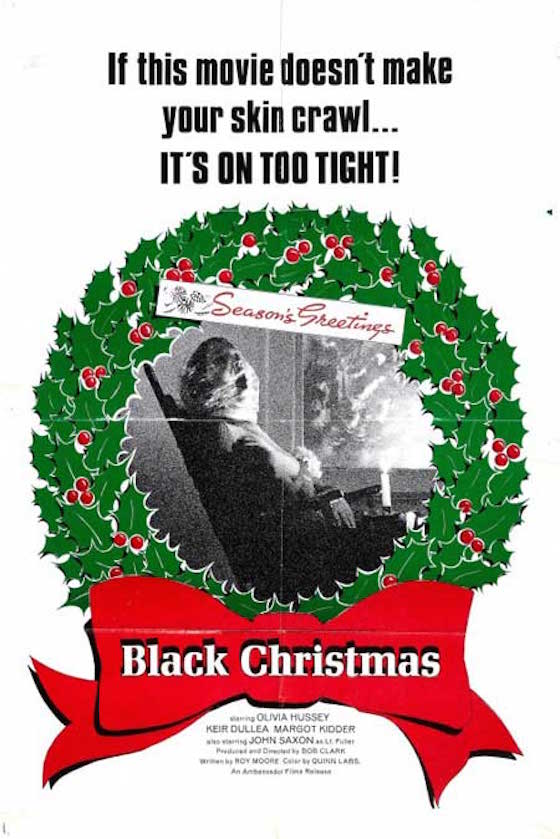
There is no real contest: Black Christmas is the definitive Canadian horror film. Not just because 40 years after its release it remains to be creepy and thrilling, but because it invented the slasher prototype. Every movie from Halloween to Friday the 13th to Scream borrowed Bob Clark's blueprint of a crazed serial killer stalking teenagers, but even by comparison his deserves the honour of the greatest slasher ever. Set inside a sorority house during the holiday season (shot on the U of T campus), a mysterious caller keeps harassing one sister named Jess (Olivia Hussey); unbeknownst to her, each of her sisters is being killed off throughout the house. An adaptation on "The Babysitter and the Man Upstairs" urban legend, Clark's use of the killer's POV adds an unsettling element that was undoubtedly the inspiration for Michael Myers' first kill in Halloween. What might be the film's greatest achievement, however, is making the protagonist not only a young woman, but also a young woman who's pregnant, which at the time was the unlikeliest hero against a homicidal lunatic. With supporting turns by familiar faces in John Saxon, Margot Kidder and Art Hindle, Black Christmas is a favourite film of every horror fanatic, and not just noted fan Steve Martin.
What To Avoid:
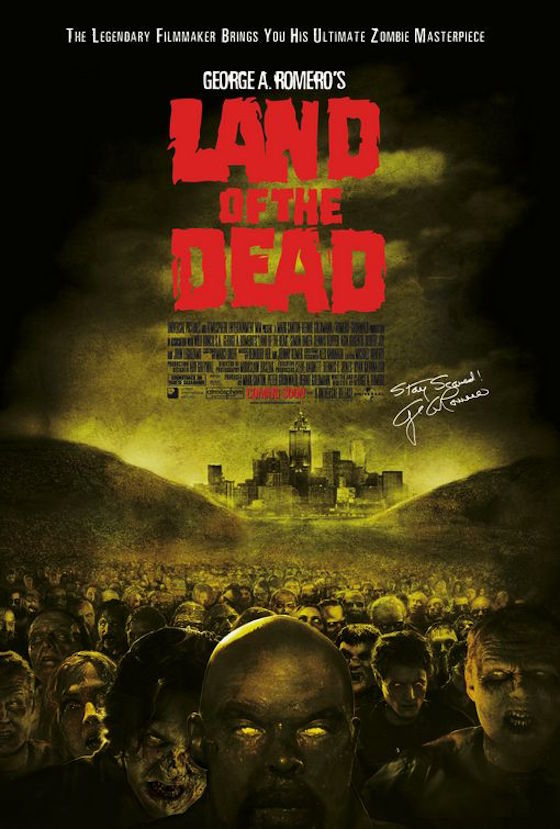
Not all of these franchises, however, are co-productions. Prom Night, a classic slasher that snagged Jamie Lee Curtis, fresh off the first two Halloween films, launched a series of films that descended into the inane. The original presented a somewhat logical premise – a masked killer seeks revenge for the death of a young girl and terrorizes high schoolers on prom night – and yet, from there it opted to fall into absurdist supernatural phenomena with the next two sequels. I'll give Hello Mary Lou: Prom Night II some credit: it is fabulously over the top and a real guilty pleasure. However, its successors, The Last Kiss and Deliver Us From Evil, which is so far off base it doesn't even feature a prom, are pure trash.
Even George A. Romero had his moments of failure up here in Canada, writing and directing two zombie flicks that failed to capitalize on the first three installments of his "Living Dead" series. Land of the Dead was a disappointing attempt to re-enter the genre he invented. Despite its sizeable budget, it felt like a modern retread of its predecessor, Day of the Dead. Meanwhile, the last two entries, Diary of the Dead and Survival of the Dead made cases for the director to hang up his slate.
The late 1990s and 2000s were a rough time for Canadian horror. There was a real glut of straight-to-DVD productions hitting the market with uninspired titles like Evil Breed: The Legend of Samhain, Avalanche Sharks and Decoys 2: Alien Seduction.
Further Viewing:

If you want to go back to the very beginning, The Mask (1961) is recognized as the first ever Canadian horror flick. This cult classic, originally released in 3D, is a dark and disturbing trip about a psychiatrist who comes into the possession of an antique mask that gives him psychedelic and nightmarish visions. Why The Mask was so effective was because of its use of 3D technology, instructing the viewer to don the red and blue glasses whenever the doctor muttered, "Put the mask on, NOW!" The film has recently been digitally restored, and received a week-long run at the TIFF Lightbox in Toronto.
Though it narrowly missed out on the list, Ginger Snaps (2000) is one of the most inventive horror films ever made. Teenage sisters are attacked by a werewolf; one of them turns, and the other tries to help her sister cope and eventually reverse the affliction. Like An American Werewolf In London, Ginger Snaps (and its 2004 sequel) blend horror with black comedy, but turn the convention on its head by turning in a teenage girl's transformation into a metaphor for menstruation. With a wildly original script by Karen Walton, Ginger Snaps is fun, subversive and a rare feminist horror that goes to bat for teenage female empowerment.
Before he made Black Christmas, Bob Clark made Deathdream (1972), a nasty little film in Florida about an allegedly deceased Vietnam vet who unexpectedly returns home to his family undead and hungry for blood. Not explicitly a zombie (he can walk and talk and socialize) or a vampire (he uses blood as a youth serum and prefers to inject it rather than drink it) flick, Clark presented audiences with a refreshingly ambiguous yet extremely creepy premise that surprisingly hasn't been rebooted yet.
Remember how Kevin McAllister in Home Alone mistakenly thought the old guy with the shovel was a killer? Maybe Kevin watched Deranged: Confessions of a Necrophile (1974) at a very young age and couldn't shake the resemblance between his neighbour and Ezra Cobb. Like Norman Bates, Leatherface and Hannibal Lecter, Cobb was another fictional character based on real life serial killer Ed Gein, who digs up corpses and kills innocent women, then cross-dresses in their flesh. Like The Texas Chain Saw Massacre, which came out the same year, it's a haunting flick that feels unsettlingly real.
Other horror worth tracking down on VHS include Richard Ciupka's casting call whodunit, Curtains (1983), starring The Brood's Samantha Eggar and features the infamous "ice skating scene" and a truly grotesque killer mask; The Changeling, a creepy, good old fashioned ghost story starring George C. Scott as a famous composer who loses his wife and daughter to an accident and moves into a turn of the century mansion to resume his career, only to find it haunted by a dead child's ghost; The Corpse Eaters, arguably the first real graphic zombie film and definitely the first to both be shot in Sudbury and force the cast to drink Molson Ex; the Hal Holbrook-starring wilderness thriller, Rituals (a.k.a. The Creeper), which earned the nickname "Northern Deliverance;" and Cannibal Girls (1973), Ivan Reitman's second film, starring a young Eugene Levy and Andrea Martin as a couple whose car breaks down in the middle of winter and become stranded in a small town run by the titular, human-eating characters. The film was deemed so controversial at the time, that during screenings the sound of a bell in the theatre would warn the "squeamish or prudish" viewers to close their eyes so they could avoid "witnessing certain scenes of an especially erotic or gruesome nature."
